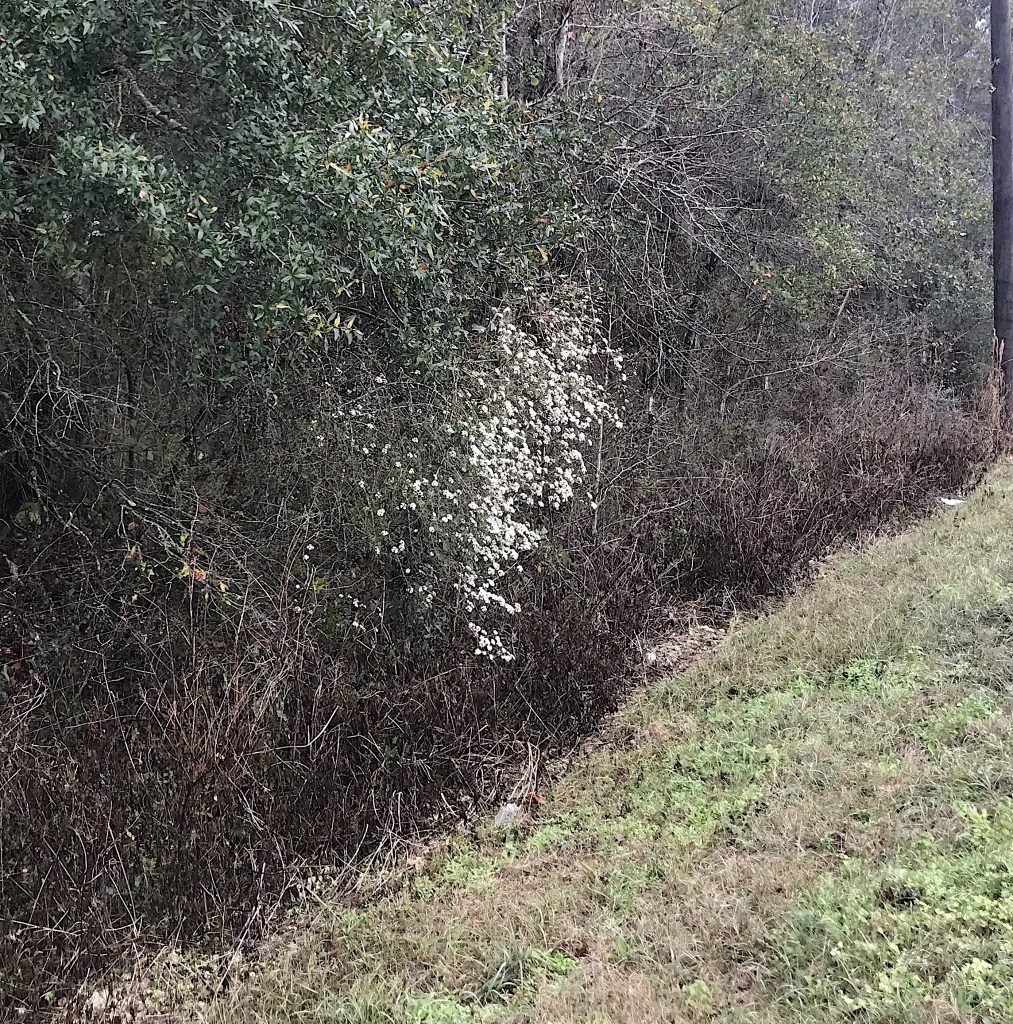
BROOKSVILLE FL: How do you find plum tress? This time of year it is easy. They are heavy with blossoms and no or few leaves. Photo by Green Deane
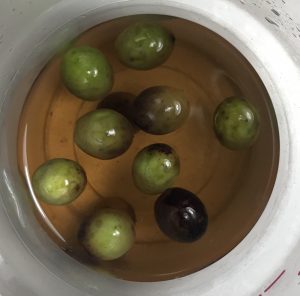
Beginning the brining.
There are can be many reasons why an edible wild plant is not eaten. Often they were replaced by a better cultivated crop, or they were eaten in other parts of the world but not locally. Sometimes one group ate it but their rivals did not, or one group only the seeds and another group only the roots. And sometimes the information was not shared leaving the plant in modern foraging limbo. Foresteria are in the olive family. As far as I know locals only used the fruit of one, F legustrina, and then to make ink. The fruit is bitter, but so, too, is the common olive without brining. Two Foresteria, F. neo-mexicana and F. pubescens var. pubescens, were eaten raw. Thus I did an experimental brining F. legustrina fruit (the southern privit. A close relative I’d also like to try is F. segregata, often used in landscaping. It has a lot of small fruit in clusters along the stems.)
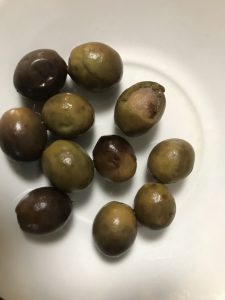
After brining a month.
Brining means soaking the fruit covered in salted water (in this case submerged in a 10% solution) for a month and changing it every week essentially the same processed as fermenting. Salt is often used to reduce tannins and is part of the process of turning Java Plums into wine. One critical element when fermenting or brining is the material you are treating has to be submerged. If any part is out of the liquid it will grow mold. I used a glass plug to keep this fruit the solution. After a month of brining the Foresteria fruit had lost its bitterness and had an acceptable taste. The seed is most of the fruit leaving little pulp to eat. It was a lot of attention and time for a small amount of payoff. Then again we don’t eat a lot of plants for their caloric punch. As the forager Ray Mears has often said every little bit fills the soup pot or tummy. These did taste like cured olives. There are at least 10 species of Foresteria in the United States, mostly the southern half from the Carolinas west to California.
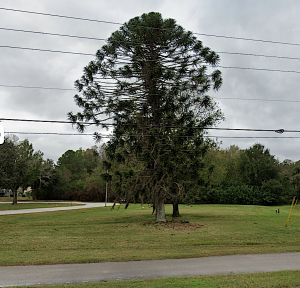
Bunya Bunya tree east Tarpon Springs, Fl.
One of the more sought after trees for the forager is the Bunya Bunya. Like it’s relatives it is an easy tree to spot: Tall, oddly shaped, and dropping edible 20 pound pine cones. There is no one place to find them though parks are a good place to start. Someone had to plant them half a century ago or more. They do fruit here in Florida, about every three years around August. A friend of mine planted one in his back yard in the 60’s and there are some scattered here and there in greater Orlando (they also like the gulf coast and Pacific shore along western United States.) This particular tree is just west of 3280 Keystone Rd, Tarpon Springs, FL 34688, which is East Lake Fire Rescue Station 58. That might tell us two things: One is if you are harvesting cones someone from the fire station might ask what you are doing (answer: keeping a non-native species from becoming invasive) and, they also might have noticed when the tree last dropped cones. They start fruiting around 15 years old. You can read my article about them here, and a video here.
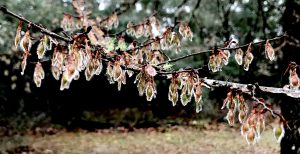
They look flimsy but they are tender and tasty: Drake Elm Leaves. Photo by Green Deane
Young and tender describes them best: Elm leaves we nibbled during our foraging class in Sunday. As far as I know all elm leaves are edible except one that grows in Manchuria, Ulmus propinqua. As the Dutch Elm Disease wiped out most elms in North American the most common elms now are the planted Lacebark Elm and it’s cousin the Siberian Elm. Florida’s elms escaped the disease and can be found often in river plains and other damp locations. The leaves have calcium, manganese, iron, magnesium, phosphorus, potassium, selenium, zinc, beta-carotene, vitamin C, and some B vitamins. They also have harder things to say such as D-galactose acid, D-galacturonic acid, L-rhamnose acid, Oleic acid, Palmitic acid, Polyphenols, Tannin, and oligomeric procyanidins (the latter have antiseptic and anti-allergic action.) For more information on elms go here or for a video here.
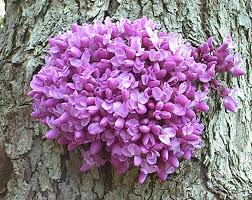
Blossoms of the Eastern Red Bud. Photo by Green Deane
Most trees in the Pea Family are toxic but not all of them. One of the edible ones is blossoming now: The Eastern Redbud. The lanky tree is very easy to spot this time of year because it has small pink blossoms and few leaves. Those small flowers — about the size of your fingernail — are important because there’s an ornamental tree with pink flowers also blossoming now that is not edible, the Pink Tabebuia. The Pink Tabebuia, however, has large blossoms about the same size as an Azalea blossom. The Eastern Redbud provides quite a few edibles: Tiny blossoms, young leaves, and pea pods. The Pink Tabebuia, T. heterophylla, does not have edible parts nor does two of its relatives, the Yellow Tabebuia, T. chrysotricha, and the Silver Trumpet Tree, T. caraiba. However, a fourth one in Florida, T. impetiginosa, or Purple Trumpet Tree, has seen its inner bark used as an herbal tea. Among those who have sipped and liked the tea are Ghandi and Czar Nicholas II of Russia. You can read more about the Eastern Red Bud here, video here.

Classes are held rain or shine or cold. (Hurricanes are an exception.) Photo by Kelly Fagan.
Foraging classes: Crossing the state this weekend for foraging classes, Spruce Creek in Port Orange south of Daytona Beach and Eagle Lake Park in Largo, north of St. Pete.
Saturday February 12th, Spruce Creek Park, 6250 Ridgewood Ave. Port Orange, 9 a.m. to noon, meet at the pavilion.
Sunday February 13th, Eagle Park Lake, 1800 Keene Road, Largo, FL 33771. 9 a.m. to noon. Meet at the pavilion near the dog park.
Saturday February 19th, Dreher Park, 1200 Southern Blvd., West Palm Beach, 33405. 9 a.m. to noon, meet just north of the science center.
Sunday February 20th, Blanchard Park, 10501 Jay Blanchard Trail, Orlando, FL 32817. 9 a.m. to noon. Meet at the pavilion next to (east of) the tennis courts.
Saturday February 26th, Tide Views Preserve, 1 Begonia Street, Atlantic Beach Fl 32233 (near Jacksonville Fl.) 9 a.m. to noon. Meet at the parking lot.
Sunday February 27th, Mead Garden: 1500 S. Denning Dr., Winter Park, FL 32789. Meet at the bathrooms. 9 a.m. to noon.
Saturday March 5th, John Chestnut County Park: 2200 East Lake Road, Palm Harbor, FL 34685. Meet at the trail head of the Peggy Park Nature Walk, pavilion 1 parking lot. 9 a.m. to noon.
Sunday March 6th, Mead Garden: 1500 S. Denning Dr., Winter Park, FL 32789. Meet at the bathrooms. 9 a.m. to noon.
Saturday/Sunday May 7th & 8th, Honea Path, South Carolina, classes at 9 a.m. and 1 p.m. each day.
For more information, to pre-pay or sign up go here
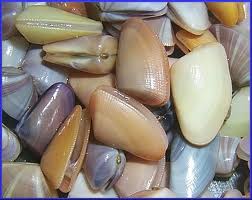
Coquina are tasty but quite small.
Sometime instead finding answers they find you. As you know there are several articles on the EatTheWeeds website that are about edibles covered by the subtitle: And other things, too. That subtitle was intentionally added when the site went up some 20 years ago. There are a lot of things in the world to eat. Before Andrew Zimmern was traipsing around the globe for the Travel Channel eating untraditional food EatTheWeeds was writing about them. As one might expect that has caused a good amount of disagreeing mail. Many people keep as pets creatures that other people eat. Thus far, however, no one has complained about Coquina, a coastal clam that’s about the size of your fingernail. The tiny clams make an absolutely delicious green broth that I like to add — I know it’s sacrilege — instant potatoes and butter to. One of the down sides is that the clams are so small getting the meat out of the shell is microscopic work. That is so frustrating as most of it is tossed away. However in Australia they figured out a commercial way of separating meat and shell. How that was done was something of a mystery until a post on the Green Deane Forum provided an answer. The cooked shells are vigorously stired. After that it is a matter of straining the shells from the meat. I’ve got to try that. You can read about Coquina here, and the crunchy Mole Crabs, here. A video on both of them is here.

Green Deane videos are now available on a USB.
My nine-DVD set of 135 videos has been phased out and replaced by a 171-video USB. The USB videos are the same videos I have on You Tube. Some people like to have their own copy. The USB videos have to be copied to your computer to play. If you want to order the USB go to the DVD/USB order button on the top right of this page or click here. That will take you to an order form. Or you can make a $99 donation, which tells me it is for the USB (include a snail-mail address.) I’d like to thank all of you who ordered the DVD set over the years which required me to burn over 5,000 DVDs individually. I had to stop making them as few programs now will read the ISO files to copy them.

Green Deane Forum
Want to identify a plant? Perhaps you’re looking for a foraging reference? You might have a UFO, an Unidentified Flowering Object, you want identified. On the Green Deane Forum we — including Green Deane and others from around the world — chat about foraging all year. And it’s not just about warm-weather plants or just North American flora. Many nations share common weeds so there’s a lot to talk about, such as the one to the left. There’s also more than weeds. The reference section has information for foraging around the world. There are also articles on food preservation, and forgotten skills from making bows to fermenting food. Recent topics include: California Wild Mushroom Parties, A Good Reason To Eat Wild Garlic, Black Walnuts and Amaranth, Sea Salt and Plastic, Wild Mustard? Heavy Metals. Oriental Persimmons. What is it? Pine Cough Drops and Needles, Skullcap, Malodorous Plant? Another NJ Tree, Maypop? Roadside Plant, Unknown in Sudan, Please Help Identify, and Preserving Prickly Pear Bounty. You can join the forum by clicking on the button on the upper right hand side of this page.
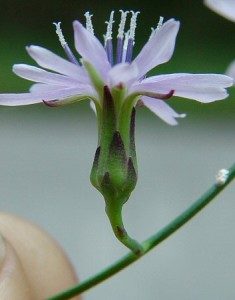
Florida lettuce blossom.
I got distracted and did not give a thorough answer: Did I know where to find wild garlic? Yes and if you know what it looks like and where it likes to grow you can find it now. However it is more showy in April and easier to find. Then a refinement of the inquiry changed the plant to “wild opium lettuce.” That species — Lactuca virosa — is an internet darling that is common in Europe and rare in the Americas. In the U.S. I think it is reported in only six counties: Two in Alabama, two near Washington D.C. and two about San Francisco. The bad news is research as far back as the 1930’s showed it is not an opium substitute having only minor effects. It is so good as an opium substitute that it is not illegal anywhere. Ponder that. Unfortunately the book that was being referenced misnamed the plant as well mentioning one that does grow here. There are four lettuces locally, all edible, none recreational. You can read about them here.
This is my weekly newsletter #494. If you want to subscribe to this free newsletter you can find the sign-up form in the menu at the top of the page. My website, EatTheWeeds.com, which is data secure, has over 1500 plants on it in some 428 articles. I wrote every one myself, no cut and paste. Every typo and misspelling is totally mine.
To donate to the Green Deane Newsletter click here.


Where can I buy solanun Burbabkii or wonder berry?
https://www.tradewindsfruit.com/content/wonderberry.htm